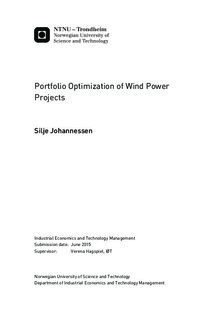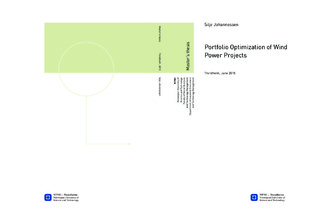| dc.description.abstract | The use of traditional discounted cash flow approaches for valuing and comparing investment opportunities are prevailing in most industries, and the same is the case for renewable energy investments. As the wind power industry is subject to high uncertainty in electricity prices, the traditional approach might fail to establish the desired overview for making the correct investment decisions because it does not incorporate the value of managerial flexibility.
In this thesis a real options approach to capital budgeting decisions in wind power is analyzed, and the method's suitability is evaluated in relation to a traditional discounted cash flow approach. The hypothesis is that the real options approach will improve the quality of the information in the decision making process, and optimize the project selection for wind power portfolios.
The model developed in this thesis is applied to TrønderEnergi's investment portfolio. The projects considered are located in Central Norway, an area where several companies are currently evaluation investments in wind power. The companies currently evaluating investments are facing a deadline due to the tradable green certificate market. In addition, many of the wind parks in Central Norway depend on the upcoming decision about the upgrade in the central grid, thus resulting in a complex situation for the decision makers. The upgrade in the central grid is triggered if enough capacity is developed in the Fosen area. Companies with concessions to invest in this area created the joint company Fosen Vind to coordinate investments of enough capacity to trigger the grid investment. TrønderEnergi currently owns 14.5 percent of this company, but has the option to reduce its interest. This thesis will therefore consider several investment strategies for TrønderEnergi, depending on the ownership interest they hold in Fosen Vind.
To investigate the investment opportunities, the practical conditions affecting the investment decision are discussed. First, some general information about investment in wind power and an overview of the current wind power development in Central Norway is presented, followed by a detailed presentation of TrønderEnergi's investment situation. Further the relevant literature on real options and capital budgeting under uncertainty is briefly presented followed by a detailed introduction to the relevant theory used in the thesis. The theory presents all relevant equations needed to perform the calculations, however, it is assumed that the reader has some basic knowledge in calculus, stochastic processes and integer programming. References are made to relevant literature if the derivation of the equations used are omitted. The theory on real options analysis and integer programming is used to develop a dynamic scenario based optimization model. The model is applied to find the optimal project selection for TrønderEnergi's wind power portfolio and the result is compared to the result from optimizing the portfolio based on the traditional discounted cash flow method.
To solve the dynamic scenarios based optimization model, a set of scenarios for the possible development in the projects' value in the future is required. In a real options framework, the value of the option to invest into a project is based on the expected future value of the revenue excluding the investment cost, where the investment cost is considered to be the strike price for the option. All projects are assumed to be exposed to the same sources of uncertainty and the development in the future expected revenue for the projects are considered to follow the same stochastic process as the electricity price. It is further assumed that the development in the electricity price can be described by a mean reverting model, due to its tendency to revert back to its long term mean. The parameters for the stochastic process have been estimated using historical data for the electricity price available at Nord Pool Spot. The binomial option pricing model is used to generate a subset of scenarios for the value of investments. The stochastic process is discretised and the value of the option to invest in each scenario is determined. The critical threshold for investment for each period is calculated to make sure investments do not take place when the option value of waiting is higher than the net value of investing. A value function, representing the value of investing in all the scenarios, is defined. The value function returns zero when investment is not optimal in a given scenario and returns the net expected value of investing when investing is optimal. The dynamic optimization model maximizes the total expected value of the portfolio based on the set of scenarios defined by the value function.
The results demonstrate roughly three times higher expected portfolio value when the dynamic model is applied, compared to the traditional capital budgeting model. It also results in significantly different project selection for several of the scenarios. The dynamic real option based model is capable of including the value of waiting to invest in projects that might have higher net expected value in the future, even though they are currently not considered the most profitable. The limitations of the traditional techniques and the potential of real options theory lead to the conclusion that a real option based capital budgeting approach should be considered when dealing with investments in wind power.
In addition to the conclusion and recommendations, a program for the valuation and scenario generation and two optimization models for the selection of projects are created. The program for the valuation and scenario generation is written in Visual Basics for Application and is included in Appendix A, while the optimization models are written in Mosel for the optimization software FICO Xpress Optimization Suite and is included in Appendix B and C. The program was created for TrønderEnergi's portfolio, but takes all parameters as inputs, is flexible in number of projects and time to maturity for the investments and can therefore be applied to other wind power portfolios with similar risk and flexibility. | |

